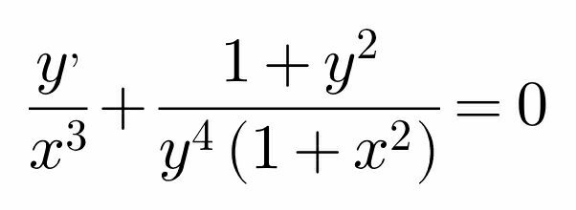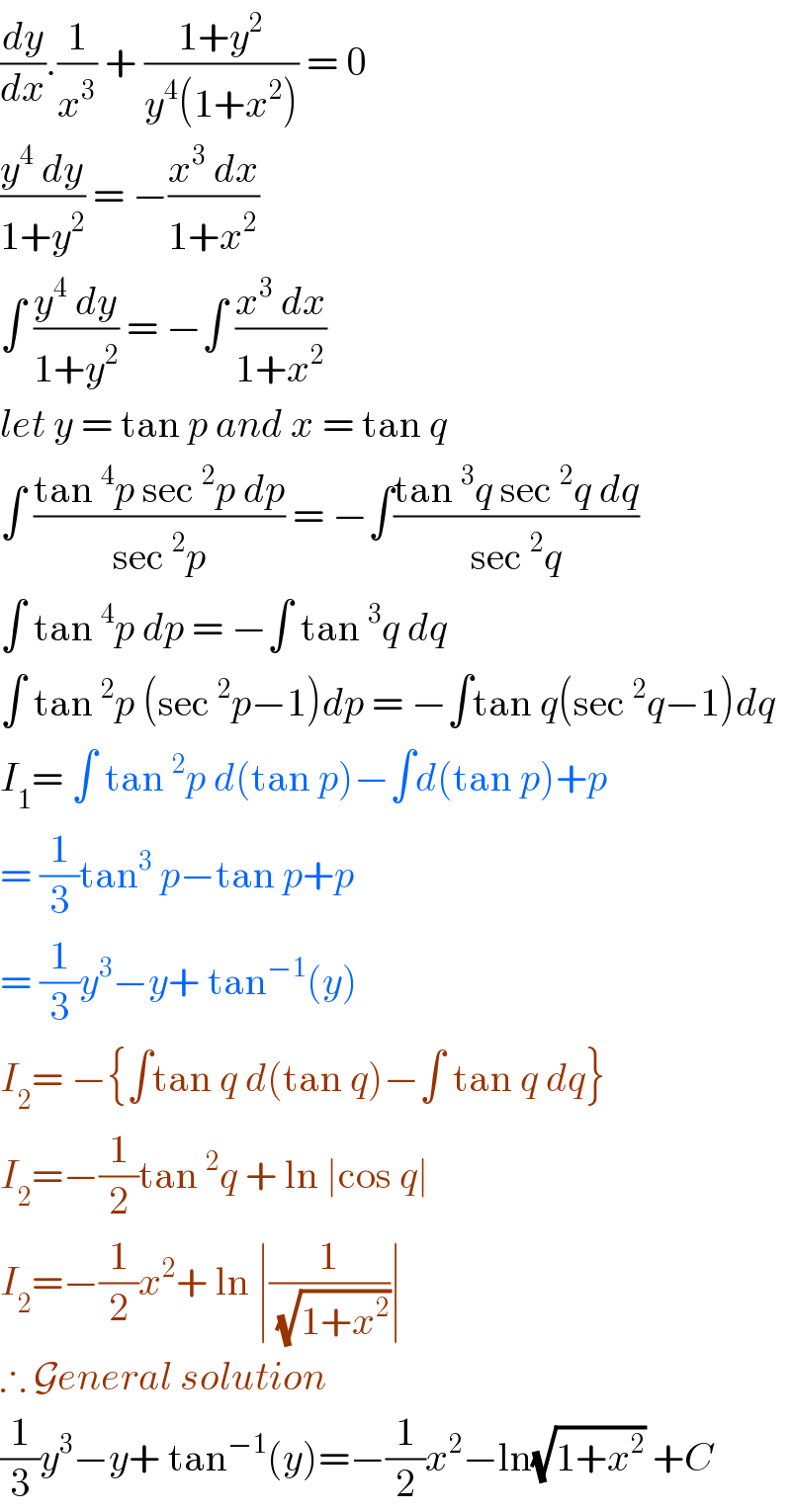Question Number 105877 by john santu last updated on 01/Aug/20

Answered by bemath last updated on 01/Aug/20

$$\frac{{dy}}{{dx}}.\frac{\mathrm{1}}{{x}^{\mathrm{3}} }\:+\:\frac{\mathrm{1}+{y}^{\mathrm{2}} }{{y}^{\mathrm{4}} \left(\mathrm{1}+{x}^{\mathrm{2}} \right)}\:=\:\mathrm{0} \\ $$$$\frac{{y}^{\mathrm{4}} \:{dy}}{\mathrm{1}+{y}^{\mathrm{2}} }\:=\:−\frac{{x}^{\mathrm{3}} \:{dx}}{\mathrm{1}+{x}^{\mathrm{2}} }\: \\ $$$$\int\:\frac{{y}^{\mathrm{4}} \:{dy}}{\mathrm{1}+{y}^{\mathrm{2}} }\:=\:−\int\:\frac{{x}^{\mathrm{3}} \:{dx}}{\mathrm{1}+{x}^{\mathrm{2}} } \\ $$$${let}\:{y}\:=\:\mathrm{tan}\:{p}\:{and}\:{x}\:=\:\mathrm{tan}\:{q}\: \\ $$$$\int\:\frac{\mathrm{tan}\:^{\mathrm{4}} {p}\:\mathrm{sec}\:^{\mathrm{2}} {p}\:{dp}}{\mathrm{sec}\:^{\mathrm{2}} {p}}\:=\:−\int\frac{\mathrm{tan}\:^{\mathrm{3}} {q}\:\mathrm{sec}\:^{\mathrm{2}} {q}\:{dq}}{\mathrm{sec}\:^{\mathrm{2}} {q}} \\ $$$$\int\:\mathrm{tan}\:^{\mathrm{4}} {p}\:{dp}\:=\:−\int\:\mathrm{tan}\:^{\mathrm{3}} {q}\:{dq}\: \\ $$$$\int\:\mathrm{tan}\:^{\mathrm{2}} {p}\:\left(\mathrm{sec}\:^{\mathrm{2}} {p}−\mathrm{1}\right){dp}\:=\:−\int\mathrm{tan}\:{q}\left(\mathrm{sec}\:^{\mathrm{2}} {q}−\mathrm{1}\right){dq} \\ $$$${I}_{\mathrm{1}} =\:\int\:\mathrm{tan}\:^{\mathrm{2}} {p}\:{d}\left(\mathrm{tan}\:{p}\right)−\int{d}\left(\mathrm{tan}\:{p}\right)+{p} \\ $$$$=\:\frac{\mathrm{1}}{\mathrm{3}}\mathrm{tan}^{\mathrm{3}} \:{p}−\mathrm{tan}\:{p}+{p} \\ $$$$=\:\frac{\mathrm{1}}{\mathrm{3}}{y}^{\mathrm{3}} −{y}+\:\mathrm{tan}^{−\mathrm{1}} \left({y}\right) \\ $$$${I}_{\mathrm{2}} =\:−\left\{\int\mathrm{tan}\:{q}\:{d}\left(\mathrm{tan}\:{q}\right)−\int\:\mathrm{tan}\:{q}\:{dq}\right\} \\ $$$${I}_{\mathrm{2}} =−\frac{\mathrm{1}}{\mathrm{2}}\mathrm{tan}\:^{\mathrm{2}} {q}\:+\:\mathrm{ln}\:\mid\mathrm{cos}\:{q}\mid\: \\ $$$${I}_{\mathrm{2}} =−\frac{\mathrm{1}}{\mathrm{2}}{x}^{\mathrm{2}} +\:\mathrm{ln}\:\mid\frac{\mathrm{1}}{\:\sqrt{\mathrm{1}+{x}^{\mathrm{2}} }}\mid\: \\ $$$$\therefore\:\mathcal{G}{eneral}\:{solution} \\ $$$$\frac{\mathrm{1}}{\mathrm{3}}{y}^{\mathrm{3}} −{y}+\:\mathrm{tan}^{−\mathrm{1}} \left({y}\right)=−\frac{\mathrm{1}}{\mathrm{2}}{x}^{\mathrm{2}} −\mathrm{ln}\sqrt{\mathrm{1}+{x}^{\mathrm{2}} }\:+{C}\: \\ $$
